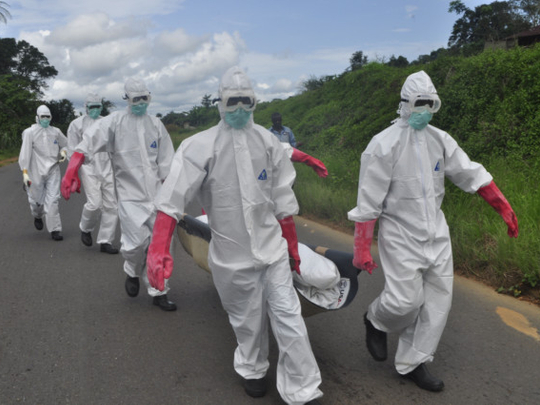
Mark Zuckerberg recently announced a donation of $25 million (Dh91.95 million) to the Centres for Disease Control Foundation to help fight Ebola. He noted that the Ebola epidemic has infected 8,400 people so far and could infect one million people or more if not addressed immediately.
Zuckerberg’s involvement is an important step forward for the technology industry and with a bit of luck, this disaster will be averted. But it is a prelude to a future in which humanity is so tightly connected that local epidemics break out frequently and spread globally within hours — and become pandemics. In addition to old diseases such as Ebola, there will be new, human inventions. Advances in biological engineering are making it possible to create deadly new viruses and to modify and weaponise exiting pathogens. It is not just governments and terrorists who will do this; high-school children may inadvertently perform the wrong synthetic biology experiment. Students are already building biological systems and operating them in living cells.
We need to be prepared for this scary future and Silicon Valley needs to take the lead in developing technologies to track, prevent and manage pandemics. It also needs to work with scientists to develop cures. It now has the ability to do all this. Advancing technologies are surely creating new risks, but at the same time, they are making it possible for entrepreneurs to do what only governments and big research labs could do before: Solve global problems.
Here are some of the technologies that entrepreneurs can build — and that we need to accelerate.
1. Patient identification and tracking systems. Just as marketers are using social media, mobile-phone logs and search data to keep track of people and send them targeted advertisements, technology can be developed to track the spread of disease and identify patients. It can keep track of who was in contact with whom, ask how they are doing and monitor their movement.
2. Education and communication. Mobile apps can help guide public-health measures, educate patients and provide guidance to caregivers on prevention and cure. Billions of people worldwide now have cellphones. Soon they will have internet-connected smartphones that can display video and run artificial intelligence-based apps. Just as the XPrize Foundation launched a $15 million prize for a digital tutor that can educate a child — without a teacher — to read, write and perform arithmetic, so can Silicon Valley create technologies that provide accurate and timely information to people who are closest to the front lines of pandemics.
3. Better and faster detection. Sensors and microfluidic-based devices can facilitate the rapid testing of disease at the point of care. BioFire Diagnostics and Nanologix are adopting their existing blood and respiratory products to test for infectious disease. These companies will benefit from an emergency-use authorisation that the Food and Drug Administration recently issued that allows them to test their technologies in the field.
Nanobiosym is developing one of the most promising technologies of all — a product called Gene-Radar, a portable nanotechnology platform that can rapidly and accurately detect genetic fingerprints from any biological organism. Anita Goel, Nanobiosym founder and chief executive, said she believes that technologies such as this will provide the best hope for addressing global pandemics.
4. Big data analysis. Just as airlines mine travel data to predict which flights are going to be full and to set airfares, data scientists can mine travel, epidemic and passenger-load data to determine the probability of a passenger’s being a disease carrier. If we know that flight X has Y per cent of passengers from affected countries in West Africa, for example, we can use these data to better predict the spread of the epidemic and to determine where to focus efforts at containment, prevention and treatment.
Entrepreneurs can also develop technologies for disease treatment and synthetic vaccines may be the key. One Silicon Valley company, Flow Pharma, is developing a biodegradable, microsphere-based vaccine-delivery platform, for example. Its co-founder, Naveen Jain, explained to me that when the vaccine is combined with adjuvants (chemicals that exaggerate an immune response), the human body treats microspheres as an infectious disease and enables them to deliver a payload to the human immune system. It can also educate the immune system to fight targets that it cannot identify on its own. The payload will be biological markers from a virus that weakens it. For Ebola, research has already been done on 1,200 biological markers. Flow Pharma is using machine learning software to determine which of these biological markers best identify the virus’ Achilles heel. Jain says that he expects this analysis to be complete in two weeks. He believes that they can develop a non-sterile vaccine prototype in less than 60 days and be ready for human tests within a year.
This is optimistic thinking, for sure. But it represents the kind of effort that we need from hundreds of Silicon Valley start-ups. In the technology industry, success is a numbers game and optimism rules the day. Many start-ups address the same problems using different approaches. They take big risks and learn from one another.
The companies that succeed in solving the problems of pandemics will surely reap the large financial returns that Silicon Valley looks for. But the social returns will be far greater. It is about saving humanity, after all.
— Washington Post
Vivek Wadhwa is a fellow at Rock Centre for Corporate Governance at Stanford University, director of Research at Duke University and distinguished scholar at Singularity and Emory universities. His past appointments include Harvard Law School and University of California, Berkeley.









